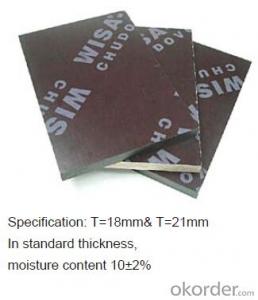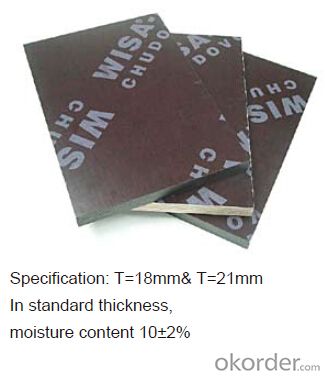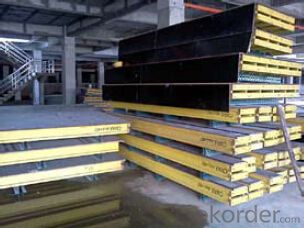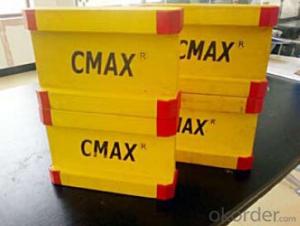Plywood-Formwork System for Formwork and Scaffolding
- Loading Port:
- Tianjin
- Payment Terms:
- TT OR LC
- Min Order Qty:
- 50 m²
- Supply Capability:
- 1000 m²/month
OKorder Service Pledge
Quality Product, Order Online Tracking, Timely Delivery
OKorder Financial Service
Credit Rating, Credit Services, Credit Purchasing
You Might Also Like
Plywood --- make perfect concrete surface
WISA-Form Birch is a coated special plywood using in the formwork systems where high
requirements are set on the concrete surface and the times of reuses.
With CNBM timber beam & WISA plywood, the formwork is low weight but high load capacity, it is
widely used in construction.
Characteristics:
◆ Component with high standardization.
◆ Assembling in site, flexible application.
◆ Light weight, easy transportation and storage.

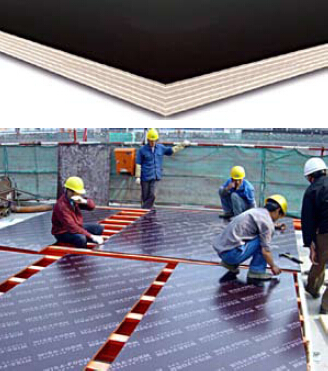
- Q: What are the safety precautions when working with steel formwork?
- To ensure the safety of workers when using steel formwork, it is important to adhere to specific safety measures. These measures encompass the following: 1. Comprehensive training: All workers must undergo thorough training on the proper usage of steel formwork. This entails understanding how to assemble, disassemble, and handle the formwork system. Additionally, workers should be trained to identify any potential risks or hazards associated with steel formwork. 2. Utilization of Personal Protective Equipment (PPE): Workers should consistently wear appropriate PPE, which typically consists of safety helmets, steel-toed boots, high-visibility vests, and gloves. Depending on the tasks involved, additional PPE such as safety glasses or respiratory protection may be necessary. 3. Secure and stable installation: Prior to commencing work, it is crucial to securely and stably install the steel formwork. This involves proper anchoring and bracing to prevent any movement or collapse during use. Regular checks should be conducted to ensure the formwork remains stable throughout the project. 4. Safe access and egress: Workers must have safe and unobstructed access to the steel formwork. This may require the installation of secure ladders, platforms, or scaffolding to provide a stable means of reaching the formwork. Adequate lighting should also be provided to enhance visibility and prevent accidents. 5. Regular inspections: Regular inspections of the steel formwork should be carried out to identify and address any signs of wear, damage, or deterioration. This includes checking for bent or damaged components, loose connections, or signs of corrosion. Prompt action should be taken to rectify any issues and maintain the integrity and safety of the formwork. 6. Proper lifting and handling techniques: When moving or lifting steel formwork components, workers should employ appropriate lifting techniques and equipment. This may involve the use of cranes, hoists, or forklifts, depending on the size and weight of the components. Adequate training and supervision should be provided to ensure adherence to safe lifting practices. 7. Effective communication: Clear communication among workers is paramount when working with steel formwork. This can be achieved through the use of hand signals, radios, or other communication devices to relay important information or warnings. Additionally, clear signage and barriers should be employed to indicate restricted areas or potential hazards. By adhering to these safety precautions when working with steel formwork, the risk of accidents, injuries, or structural failures can be significantly minimized, resulting in a safer working environment for all individuals involved.
- Q: What are the different surface treatments available for steel formwork panels?
- Steel formwork panels can be treated with various surface treatments to enhance their durability and performance. Some common options include: 1. Galvanization: By immersing the panels in molten zinc, a protective layer is formed on the surface. This treatment is ideal for outdoor and highly corrosive environments due to its excellent corrosion resistance. 2. Powder coating: A dry powder coating is applied to the steel surface and then cured under heat. This provides a durable and visually appealing finish with resistance to corrosion, abrasion, and chemicals. Additionally, a wide range of colors and textures can be achieved. 3. Epoxy coating: Liquid epoxy coatings are applied to the steel surface and then cured to create a hard and protective layer. This treatment offers exceptional resistance to corrosion, chemicals, and abrasion, making it suitable for harsh conditions. 4. Paint: Various types of paint can be used to create a protective layer and improve aesthetics. The level of resistance to corrosion, UV radiation, and wear depends on the specific paint used. 5. Shot blasting: High-speed steel shot or grit particles are used to blast the surface of the steel formwork panels. This process removes rust, scale, and contaminants, creating a clean and roughened profile that enhances the adhesion of subsequent coatings. 6. Hot-dip aluminizing: The panels are immersed in molten aluminum to form a thin layer on the surface. This treatment offers excellent corrosion resistance and heat reflectivity. These surface treatments provide different levels of protection against corrosion, abrasion, chemicals, and environmental factors. The choice of treatment depends on the specific application and desired durability.
- Q: How does steel formwork affect the overall sustainability of a construction project?
- The overall sustainability of a construction project can be significantly influenced by the use of steel formwork. Firstly, the durability and reusability of steel formwork greatly reduces the need for constant replacement, resulting in minimal waste generation and a reduced environmental footprint. This not only benefits the project's environmental impact but also aids in cost reduction. Additionally, the use of steel formwork ensures a high level of accuracy and precision, leading to efficient and streamlined construction processes. This in turn reduces material wastage and energy consumption, contributing to the sustainable use of resources. Moreover, the utilization of steel formwork enables faster construction cycles, resulting in decreased overall energy consumption and greenhouse gas emissions. Furthermore, steel formwork offers versatility in design, allowing for the creation of complex and innovative architectural structures. This versatility enhances the aesthetic appeal of a building, promoting its long-term use and decreasing the likelihood of demolitions due to outdated designs. By extending the lifespan of a structure, steel formwork contributes to the sustainability of the project by reducing the need for additional construction and material usage. In addition, steel formwork plays a crucial role in ensuring the overall structural integrity and safety of a building. Its strength and rigidity provide stability during both construction and throughout the lifespan of the structure. This reduces the risk of structural failures and the need for repairs or reconstruction, consequently minimizing waste generation and resource depletion. To summarize, the use of steel formwork has various positive impacts on the overall sustainability of a construction project. Its durability, reusability, precision, efficiency, versatility, and structural integrity contribute to the reduction of waste generation, energy consumption, and greenhouse gas emissions. By promoting the sustainable use of resources and contributing to the long-term viability of buildings, steel formwork plays a crucial role in sustainable construction practices.
- Q: How does steel formwork handle concrete curing additives?
- Steel formwork is a popular choice for concrete construction due to its durability and strength. When it comes to handling concrete curing additives, steel formwork is highly compatible and can effectively accommodate the use of such additives. Concrete curing additives, such as accelerators or retarders, are used to modify the setting and hardening time of concrete. These additives are typically added to the concrete mixture during the mixing process or applied to the surface of the formwork before pouring the concrete. Steel formwork is not adversely affected by the presence of curing additives in the concrete. It is resistant to chemical reactions and can withstand the potentially corrosive nature of certain additives. This ensures that the steel formwork remains structurally sound and maintains its integrity throughout the concrete curing process. Furthermore, steel formwork offers a smooth and non-porous surface, which allows for easy application and penetration of curing additives. This facilitates the even distribution of additives across the concrete surface, promoting consistent curing and optimal strength development. Moreover, steel formwork is reusable, which means that it can be used for multiple concrete pours. This reusability factor is particularly advantageous when working with concrete curing additives, as the formwork can be easily cleaned after each use, ensuring that no residue or build-up of additives remains on the surface. This helps to prevent any potential interference with subsequent concrete pours or compromising the quality of the cured concrete. In summary, steel formwork is well-suited for handling concrete curing additives. Its chemical resistance, smooth surface, and reusability make it an ideal choice for accommodating the use of curing additives, ensuring efficient and effective concrete curing.
- Q: Can steel formwork be used for tunnel linings?
- No, steel formwork is typically not used for tunnel linings. Instead, materials like concrete or shotcrete are commonly used for tunnel linings due to their strength and durability.
- Q: Is steel formwork suitable for projects with high formwork reusability?
- Yes, steel formwork is highly suitable for projects with high formwork reusability. Steel formwork is known for its durability, strength, and longevity, making it ideal for repetitive use in construction projects. It can withstand multiple pour and stripping cycles without significant wear and tear, ensuring cost-effectiveness and efficiency in projects that require frequent formwork reuse. Additionally, steel formwork offers excellent dimensional stability, allowing for precise and accurate concrete shaping and finishing.
- Q: What are the considerations when designing steel formwork for bridges?
- When designing steel formwork for bridges, there are several important considerations that need to be taken into account. First and foremost, the structural integrity and stability of the formwork system is of utmost importance. It is crucial to ensure that the steel formwork is capable of withstanding the loads and forces imposed during the construction process. This includes the weight of the wet concrete, as well as any additional loads such as equipment or workers. Another important consideration is the dimensional accuracy and smoothness of the finished concrete surface. The formwork must be designed to provide the desired shape and finish for the bridge components. It should be able to maintain the specified tolerances and prevent any distortion or misalignment during the pouring and curing of concrete. The ease of assembly, disassembly, and reusability of the steel formwork is also a key consideration. The formwork system should be designed to be easily assembled and adjusted to accommodate different bridge geometries. It should also be easy to dismantle and move to the next construction site. Additionally, the ability to reuse the formwork for multiple projects can lead to significant cost savings. The safety of the workers involved in the construction process is another important consideration when designing steel formwork for bridges. The formwork should be designed to provide a safe working environment, with features such as guardrails, access platforms, and proper anchorage systems. It is crucial to adhere to all relevant safety regulations and standards to prevent accidents and injuries. Lastly, the cost-effectiveness of the steel formwork system should be considered. The design should aim to minimize material usage and optimize the construction process to reduce overall costs. This can be achieved through efficient design and manufacturing techniques, as well as the use of high-quality and durable materials. In conclusion, the considerations when designing steel formwork for bridges include structural integrity, dimensional accuracy, ease of assembly and reusability, worker safety, and cost-effectiveness. By addressing these factors, engineers can ensure the successful construction of bridges that meet all requirements and standards.
- Q: What is the maximum load capacity of steel formwork?
- The maximum load capacity of steel formwork can vary depending on several factors such as the thickness and quality of the steel, the design of the formwork system, and the type of load being applied. Generally, steel formwork is known for its high load-bearing capacity and durability, making it suitable for heavy-duty construction projects. In practice, the load capacity of steel formwork is typically determined by conducting load tests and following engineering calculations. These tests involve applying specific loads to the formwork and measuring its ability to withstand them without failure or deformation. While it is not possible to provide an exact figure for the maximum load capacity of steel formwork without specific information about the formwork system in question, it is common for steel formwork to have load capacities ranging from several hundred kilograms per square meter to several tons per square meter. However, it is essential to consult the manufacturer's specifications, engineering documentation, or an experienced structural engineer to determine the precise load capacity of a particular steel formwork system to ensure safe and efficient construction practices.
- Q: What are the different types of bracing used with steel formwork?
- There are several types of bracing commonly used with steel formwork, including diagonal bracing, horizontal bracing, and vertical bracing. Diagonal bracing is used to provide stability and resistance against lateral forces, while horizontal bracing helps to control deflection and ensure the formwork remains in place. Vertical bracing is used to support the formwork system vertically and prevent any potential collapse. These different types of bracing work together to ensure the safety and stability of the steel formwork during construction.
- Q: Can steel formwork be used for tunnel construction?
- Yes, steel formwork can be used for tunnel construction. Steel formwork refers to the temporary or permanent molds made from steel that are used to shape and support concrete during the construction process. In tunnel construction, steel formwork is commonly used to create the tunnel lining, which provides structural support and protects the tunnel from external forces. Steel formwork offers several advantages for tunnel construction. Firstly, it is strong and durable, capable of withstanding the pressures and forces exerted on the tunnel structure. This makes it suitable for constructing tunnels in various ground conditions, including soft soils, rock, or even underwater. Secondly, steel formwork can be easily customized to the required shape and size, allowing for flexibility in tunnel design. It can be prefabricated off-site and then assembled on-site, reducing construction time and costs. Additionally, steel formwork is reusable, which further enhances its cost-effectiveness and sustainability. Furthermore, steel formwork provides a smooth and high-quality finish to the tunnel lining, ensuring the structural integrity and longevity of the tunnel. It also allows for the easy installation of other tunnel components, such as electrical conduits, ventilation systems, and drainage pipes. However, it is important to note that the selection of formwork material depends on various factors, including tunnel dimensions, construction method, ground conditions, and project requirements. Other types of formwork materials, such as timber or aluminum, may also be suitable for tunnel construction depending on the specific project needs.
Send your message to us
Plywood-Formwork System for Formwork and Scaffolding
- Loading Port:
- Tianjin
- Payment Terms:
- TT OR LC
- Min Order Qty:
- 50 m²
- Supply Capability:
- 1000 m²/month
OKorder Service Pledge
Quality Product, Order Online Tracking, Timely Delivery
OKorder Financial Service
Credit Rating, Credit Services, Credit Purchasing
Similar products
Hot products
Hot Searches
Related keywords
